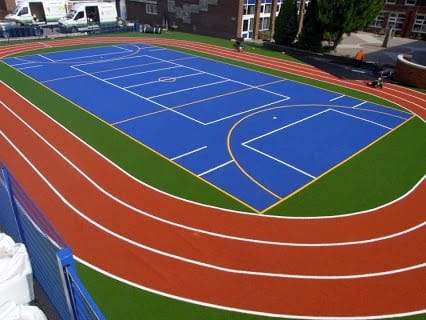- About
- Services
- Play
- Sport
- Case Studies
- News
- Contact
- Pitchbuilder
Multi-use games areas (MUGAs) are an important part of the contemporary urban landscape. They provide citizens with a safe, enjoyable and engaging environment to interact in within their local area. As such it is essential that designers create MUGAs which maximise its use by combining both practicality and aesthetics into the design process.
This article will discuss how this can be achieved through careful selection of materials, consideration of user requirements and effective integration of sustainable methods.
The first step when designing a MUGA should involve gaining insight into the needs of its users; understanding who will be using the space and what activities they intend to undertake there must form basis for further considerations. By determining these factors early on in the design process, planners can ensure that all requirements are met before investing time and resources into creating a final product.
Creating a MUGA that maximises its use requires an understanding of the user requirements in order to successfully design and implement it. As such, thoughtful consideration must be given to the users of this space so that their needs may be met.
A landscape architect should investigate how people interact with these environments as well as identify which elements are necessary for facilitating effective experiences when using the muga. This could include measurements about seating capacity or accessibility features for those who require assistance navigating within the area.
Additionally, research into activities typically enjoyed by those in the community can inform decisions on what types of amenities would benefit them most.
Designing a muga is an opportunity to provide a sense of place where individuals can come together and build meaningful relationships while participating in recreational activities they enjoy. It should be crafted with care and attention to detail, creating an atmosphere conducive to relaxation and enjoyment while ensuring safety considerations are taken into account.
With forethought put into every aspect, this type of public space has the potential to become a beloved destination for generations to come.

Selecting the appropriate materials for a muga is an important consideration. The choice of material will determine how durable, safe and attractive it appears to users. It also has implications for maintenance costs over its lifespan.
Landscape architects must select materials that are suitable for their intended use and which adhere to relevant health and safety standards. Natural materials such as stone, wood or turf can be combined with synthetic surfaces depending on user needs and site conditions.
A range of criteria should be taken into account when selecting materials including durability, slip resistance, porosity, colourfastness, texture, cost and environmental impact.
When designing a MUGA with multiple uses in mind, it may be necessary to consider using different materials in different areas to maximise its potential use. For example, areas used predominantly by children could require softer ground surfaces than those required for more intensive activities such as football or running track events.
Designers should ensure that any changes between surface types do not adversely affect performance characteristics such as drainage or traction levels. Ultimately, careful selection of the right combination of materials can help create a successful outdoor space that meets the requirements of all users while minimising long-term maintenance costs.
The design of a muga should consider the principles of sustainability to maximize its use. Sustainable design is an approach that emphasizes environmental stewardship, economic viability and social responsibility. Landscape architects must strive for creative solutions that meet these criteria in order to create successful designs.
Sustainable design seeks to reduce consumption by utilizing natural resources responsibly and minimizing waste generation. It also encourages the reuse of materials such as wood, stone, concrete or metal wherever possible. This can be done through incorporating recycled components into the construction process or repurposing existing structures instead of building new ones from scratch.
Additionally, landscape architects must select plants native to the area in order to foster biodiversity and ensure long-term ecological health.
Finally, sustainable design also requires consideration of user needs and comfort levels when selecting materials and features for a muga project. The choice of seating arrangements, lighting fixtures, shade trees and other amenities should take into account how people will actually use the space over time so they may enjoy their experience while protecting the environment around them.
By taking all these factors into account during development, designers can create a muga with lasting value that serves multiple generations without sacrificing aesthetics or function.
The design of a Multi Use Games Area (MUGA) should be carefully considered in order to ensure it is optimally used by the local community.
By taking into account user requirements, the selection of appropriate materials and incorporating sustainable design principles, an engaging MUGA can be created that meets both practical and aesthetic needs.
Symbolically speaking, this process acts as a bridge between the physical environment and its users - creating a space that will bring together people from all walks of life while respecting their natural surroundings.
Ultimately, careful consideration during the design stage allows for the creation of multi-functional spaces which offer positive experiences and make lasting impressions on those who use them. Find out innovate ways to use MUGAs.